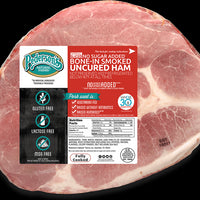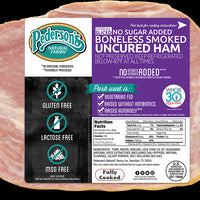Uncured ham has become a popular choice for many consumers due to its natural and unprocessed qualities. Understanding whether uncured ham is cooked or not is essential for everyone who wishes to enjoy this delectable meat option. The term "uncured" can sometimes create a misconception, leading people to wonder if the ham is safe to eat without cooking it first.
In reality, most uncured ham is thoroughly cooked when it reaches the consumer. The difference between cured and uncured ham lies in the preservation process. Traditional curing methods involve the use of preservatives like sodium nitrite, while uncured ham opts for more natural ingredients such as celery juice or sea salt. This alternative curing method results in a delicious ham with a slightly different flavor and texture than its cured counterpart.
Despite the term "uncured," this type of ham usually undergoes a cooking process during its preparation, such as smoking or baking, before it reaches the market. This means that the ham is safe for consumption, although it may require additional heating to achieve the desired tenderness and taste. It is important for consumers to read the product labels and follow the recommended preparation instructions before enjoying their uncured ham.
What Is Uncured Ham?
Uncured ham is a type of ham that is not preserved using conventional curing methods, such as the application of nitrates or nitrites. Instead, it undergoes a curing process using natural alternatives like celery juice, which contains naturally occurring nitrates. When these nitrates break down, they act as a curing agent, preserving the ham in a similar manner to traditional methods.
There are several key differences between uncured and cured hams. First, uncured ham is not injected with the same chemical brine, smoke, or flavorings used in cured meat. As a result, uncured ham may have a slightly different, yet naturally occurring color compared to the usual pink or deep rose appearance of cured ham. In fact, uncured hams are often less pink due to the absence of synthetic nitrates4.
While both fresh and cured hams undergo a process of salting to remove moisture, it is important to note that even hams labeled as "uncured" or "free of nitrates and nitrites" are still technically cured. The main difference lies in the use of natural alternatives for preservation, offering an option for those who seek a more natural approach.
When shopping for uncured ham, you may find it labeled as "farm fresh" in the grocery store. It is essential to keep in mind that since uncured ham uses natural ingredients for preservation, its shelf life may be shorter compared to that of cured ham. Therefore, proper storage and timely consumption are crucial to maintain its quality.
The Process of Making Uncured Ham
Selecting the Pork
When making uncured ham, the first step is to choose a high-quality leg of pork. This is important as the quality of the meat will have a significant impact on the final product. It is advisable to select a fresh, well-marbled leg of pork that has been raised and fed in a healthy and sustainable manner.
Preservation Techniques
Unlike cured ham, which undergoes a preservation process involving chemicals and flavorings, uncured ham is preserved using more natural methods. Typically, uncured ham is treated with a mixture of water, salt, etc., along with other natural flavorings such as cloves and herbs. This mixture helps to season the meat without the use of artificial chemicals or additives. Additionally, uncured ham may be smoked to add additional flavor and further preserve the meat.
The Role of Nitrates and Nitrites
Cured ham often contains nitrates and nitrites, which are additives that help to preserve the meat and maintain its pink color. However, these chemicals are not present in uncured ham. Instead, uncured ham relies on natural ingredients, such as celery juice or powder, as a source of nitrates. This results in a more naturally processed and flavored product. While the shelf life of uncured ham may be shorter compared to cured ham, many people prefer its more nuanced flavor and healthier ingredients.
Is Uncured Ham Cooked?
Uncured ham refers to ham that hasn't been injected with chemicals or has only been injected with natural ingredients during the curing process. This is different from cured ham, which involves injecting the meat with chemicals and flavorings to kill bacteria and make it safe for consumption.
In terms of cooking, the common understanding is that most hams sold to consumers are already cured, smoked, or baked, making them technically "pre-cooked". However, uncured ham may still require cooking, depending on its specific preparation and processing methods. When a ham isn't cooked, the label usually states the need for cooking and provides cooking instructions.
Cooking uncured ham generally involves baking it in the oven, covering it with foil, and flipping the fat side up. Additional glaze can be added after removing the ham from the oven, enhancing its flavor.
In conclusion, while uncured ham is different from cured ham in terms of the curing process, it may or may not be considered "pre-cooked" depending on its preparation. When in doubt, consumers should refer to the label for cooking instructions and guidance.
Health Implications of Uncured Ham
Uncured ham is made without injecting the same chemical brine, smoke, or flavorings used in cured meat, and is generally considered a healthier option due to the lack of additives. It is important to note, however, that uncured ham is still processed and may not be completely free of additives.
Ham is high in protein and low in carbs, fat, and fiber, making it a popular choice for those looking for a leaner meat option. A serving of just 2 ounces (57 grams) contains a considerable amount of essential amino acids necessary for muscle growth and repair.
When selecting uncured ham, it's critical to store and refrigerate it properly before consumption. Most hams should be refrigerated at a temperature of 40 degrees Fahrenheit or below and can last between three to five days.
Additionally, some types of uncured ham, like country ham and prosciutto, are dry-cured. These hams can be stored at room temperature due to their unique preservation process. Nevertheless, it's essential to be mindful of proper storage techniques to ensure food safety and avoid spoilage.
Frequently Asked Questions
Is there a taste difference between uncured and cured ham?
Yes, there is a noticeable taste difference between uncured and cured ham. Uncured ham is typically less salty and has a more natural meat flavor, while cured ham has a distinct salty taste due to the curing process. The curing method may also influence the texture and color of the ham.
How do you prepare and cook uncured ham?
Preparing uncured ham is quite similar to preparing a cured ham. Before cooking, remove any packaging and, if necessary, trim excess fat. You can then cook the ham by baking, grilling, or pan-frying, depending on your preferred method. Be sure to follow specific recipes or guidelines for time and temperature to ensure the uncured ham reaches an internal temperature of 145 degrees Fahrenheit, which is the safe threshold for consumption according to the USDA.
Can I consume uncured ham without cooking?
Most store-bought uncured ham has been fully cooked, so it is generally safe to consume without further cooking. However, it is wise to check the product packaging for any specific instructions or recommendations about cooking and preparation. If you are unsure, it's always safest to cook the ham before eating.
What distinguishes cooked ham from uncured ham?
The primary distinction between cooked ham and uncured ham is in the processing and preservation methods. Cooked ham undergoes a heating process that kills bacteria and extends its shelf life. Uncured ham has not gone through the same curing and preservation process but is typically still cooked to some degree before being sold. The curing process for uncured ham relies on natural ingredients like celery juice or sea salt rather than synthetic preservatives like sodium nitrite.
Is uncured ham safer to eat compared to cured ham?
Uncured ham is often considered a healthier and more natural alternative to cured ham since it does not contain synthetic preservatives like sodium nitrite. However, the safety of consuming uncured ham typically depends on factors like proper storage, handling, and preparation. Whether you choose uncured or cured ham, it's essential to follow safe food handling practices and cook the ham thoroughly to reduce the risk of foodborne illnesses.




